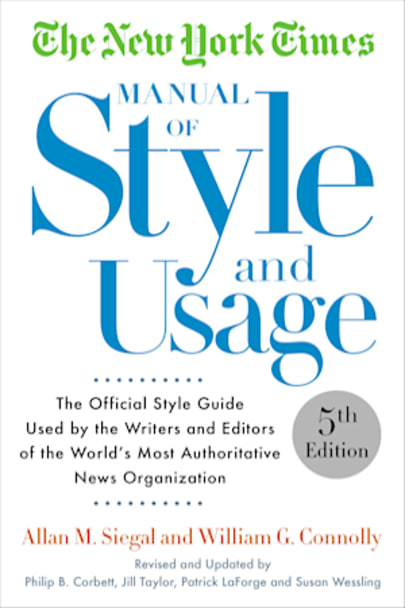The premier source for journalists, now revised and updated for 2015. Does the White House tweet? Or does the White House post on Twitter? Can “text” be a verb and also a noun? When should you link? For anyone who writes–short stories or business plans, book reports or news articles–knotty choices of spelling, grammar, punctuation and meaning lurk in every line: Lay or lie? Who or whom? That … line: Lay or lie? Who or whom? That or which? Is Band-Aid still a trademark? It’s enough to send you in search of a Martini. (Or is that a martini?) Now everyone can find answers to these and thousands of other questions in the handy alphabetical guide used by the writers and editors of the world’s most authoritative news organization.
The guidelines to hyphenation, punctuation, capitalization and spelling are crisp and compact, created for instant reference in the rush of daily deadlines. The 2015 edition is a revised and condensed version of the classic guide, updated with solutions to problems that plague writers in the Internet age:
· How to cite links and blogs
· How to handle tweets, hashtags and other social-media content
· How to use current terms like “transgender,” or to choose thoughtfully between “same-sex marriage” and “gay marriage”
With wry wit, the authors have created an essential and entertaining reference tool.
more



I originally bought this when re-releasing my novel Mitch Rebecki Gets a Life. The POV character is a New York-based reporter, so I figured this Style Guide would help me in his use of language. All well and good! As I edited, I looked up all the things that it occurred to me to look up. … Alas, it was only after I hit the publish button, and started browsing through the Style Guide for interest’s sake, that I found something I hadn’t thought to look up: “all right (never alright).”
Botherations! I was brought up with a very UK-centric use of English, and it was drummed into me at a young age that we used “all right” and Americans spelled it “alright”, and never the twain shall meet. So, alas, my Mitch got that wrong, because I didn’t even think of querying it. (I shall update the contents at some stage!)
Curious now, I started reading through the Guide from start to finish. Obviously it took me a while, and it did help with insomnia occasionally, but I enjoyed it. I do read some reference books from cover to cover, rather than only browse or refer to them, even though life is short. This one is leavened by particularly clear and succinct prose, and dashes of whimsical humour.
I love this statement of intent, from the introduction: “We are journalists — not scholars or poets, entertainers or advocates. In The Times, our goal is clear, precise, literate prose that effectively conveys important information to busy readers. Those readers should not be misled by error, distracted by sloppiness or annoyed by pedantry, polemic, slang, jargon or heedless incivility. In fact, the only time they should notice our writing at all is if, occasionally, they pause to admire it.”
Consider me paused in admiration! What fluency!
Seriously, though, I really do love this approach – and even though I write mostly fiction, this fits very nicely with my own approach to writing. Early in my creative writing courses, it was suggested to me that prose should be “accurate, brief, clear, and simple – unless there’s a good reason not to be”. That’s been my touchstone ever since, and is probably why much of this Style Guide resonated with me.
Also, the Guide expresses a desire for grace in writing: “will often require graceful explanation for readers unfamiliar with …” and “must gracefully indicate the device and the reason”, for example. How perfect!
There’s a lot of stuff in here that doesn’t have anything to do with what I write, of course. How to report bridge games and scores, for example. (Though, as the minds of fiction writers often do, mine is immediately pondering “what if…?” What if they met over a game of bridge? What if they met while chasing butterflies…?)
There’s an enormous lot of stuff that is directly relevant, too, and a surprising amount of it fits well with UK usage. If you’re looking for advice on when to use lay or lie, how to form plurals and possessives, how Roman numerals work, how to form compound words, and so on – I can’t think you’ll find more clear or succinct guidance. If you need to tweak some details to fit your local usage, of course that is absolutely fine – but I suspect you’ll find much of use and relevance in here.
I quibbled over a very few things: “soccer is what the rest of the world calls football”, for instance. Well, no. In NSW Australia, rugby league is what we call football. But that’s me being pedantic, and the authors may well have had their tongues in their cheeks. After all, I’m sure they know that one does not joke about football. And I did love their whimsical use of examples such as a “rhubarb festival”, and “Parsnip Week; Mildew Week”. … Are those real things? Google doesn’t help me, so I’ll assume they’re delightfully imaginary.
So … this is probably a longer review than some would expect for a Style Guide. But it deserves all this and more. Many thanks to the New York Times journalists and editors!